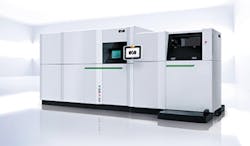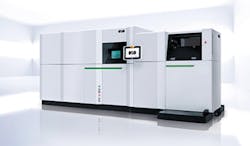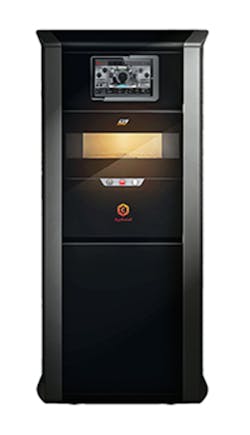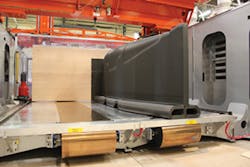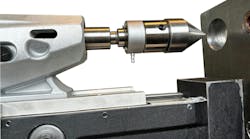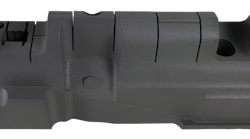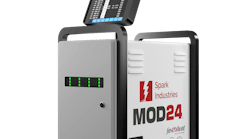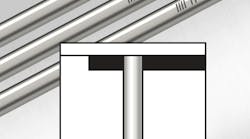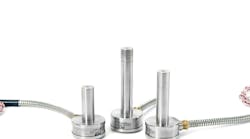3-D printer makers say their products provide a way to manufacture shapes that once might have been outside the boundaries of mold makers' capabilities. Additive, as well as hybrid additive-subtractive, technologies open new opportunities for mold makers to create complex details, such as conformal cooling channels, and allow them to turn out tooling more quickly and at lower cost. And, the tooling itself offers its users one other benefit — greater energy-efficiency.
Several 3-D printer makers, including EOS, O.R. Lasertechnologie and Thermwood, are touting the geometry-defying capabilities of their new and improved technologies.
EOS
Ankit Saharan, manager of R&D for EOS, which kicked off a new series of 3-D printers in September at IMTS 2018 in Chicago, said additive technology promises new possibilities, including "unexplored areas of applications," for the plastics industry.
Slated for commercial shipment within the next few months, the new M 300-4 is a modular printer that produces 3-D objects by melting layers of metal, in a process known as direct-laser metal sintering (DLMS). Based on EOS' existing M 290, which has a build volume of about 9.8 inches by 9.8 inches by 12.8 inches, the new printer features a build volume of about 11.8 inches by 11.8 inches by 15.8 inches.
The M 300-4 is capable of throughputs four to 10 times greater than its older sibling, Saharan said. It has four lasers, each covering the full area of the print bed, with a variety of planned configurations and power options, ranging from 400 watts to 1,000 watts; fixed-focus and variable-focus laser options are available.
Compared to earlier, smaller EOS systems, like the M 290 and M 100, the M 300-4 requires less operator input; build-plate leveling, dosing and powder-feeding processes all are automated.
Saharan said the new system features pre-installed monitoring hardware and a new, long-life filter system.
"The M300-4 not only leverages the existing advantages of DLMS technology, but builds upon this to offer additional capabilities to the user like multiple laser, full-field overlap, multiple spot size and multiple laser powers," he said. "This would open up the processing capability of the machines to not only do traditional high-carbon-steel materials, but also new materials suited for the molding industry."
Like its predecessors, the M 300-4 can print with EOS nickel alloy IN718, as well as Maraging Steel MS1, a material that's commonly used in mold components. Saharan said the company is testing the printer's capabilities with other materials, as well.
According to Saharan, the new machine is reliable and repeatable, and delivers high-quality parts at low cost. It takes up about 17.1 feet by 8.8 feet by 7.7 feet and weighs 12,125 pounds.
O.R. LASERTECHNOLOGIE
O.R. Lasertechnologie's newest machine, which will make its debut in mid- to late 2019, stands out from the company's portfolio by combining subtractive and additive capabilities. Dubbed the Creator hybrid, it is ideal for carving inside contours and undercuts and making conformal cooling channels that can't be milled.
It uses a 250-watt ytterbium laser to selectively melt metal powder, along with a milling cutter and precision computer-controlled industrial milling capabilities to create exceptional surface finishes. The machine, which employs a process known as powder bed fusion selective laser melting, operates at processing speeds of up to 11.5 feet per second in areas as small as 40 microns. It has a build platform with a diameter of about 3.9 square inches and a build height of about 3.9 inches.
Compared to traditional machining approaches, O.R. Lasertechnologie says the Creator hybrid is faster and less expensive to use. According to the company, parts made in this way are ready for use in injection molding machines and require no additional surface or heat treatment.
It can use a variety of materials, including stainless steel, cobalt chrome and bronze.
A Dieburg, Germany, subsidiary of Coherent, O.R. Lasertechnologie GmbH incorporates laser technologies into products that perform a variety of tasks, including engraving, cutting, marking and cladding.
THERMWOOD
A maker of machines that can both print and trim parts, Thermwood is touting the successful use of its new Vertical Layer Print (VLP) technology in a project involving Boeing Co.
The VLP is a table that's mounted perpendicularly to the main fixed, horizontal platform of Thermwood's Large Scale Additive Manufacturing (LSAM) machine. The VLP moves each time the LSAM's extruder prints a layer of plastic, allowing the gantry-style machine to build parts as long as 40 feet, with width and height dimensions of up to 10 feet and 5 feet, respectively.
"During VLP printing, the growing part rides on Teflon-coated stainless-steel belts," explained Jason Susnjara, the company's VP of marketing. "The belts and table drives, which can be fitted to any LSAM that is at least 20 feet long, have been designed to process parts which weigh up to 50,000 pounds."
Boeing recently used the setup to produce a single-piece mold; traditional methods might have required that the tooling be made in multiple steps and parts. In a press release, Michael Matlack, a research and technology engineer for the Chicago-based aviation giant, estimated that using the technology enabled it to save weeks in the development of the tooling.
The LSAM prints large beads of plastics, including composites, at room temperature, and a patented compression wheel fuses the layers together. In recent months, Boeing, which produced its tooling for an interior trim fixture from carbon-fiber-reinforced ABS, purchased an LSAM with VLP for its Interiors Responsibility Center in Everett, Wash.
Karen Hanna, copy editor
Contact:
EOS North America, Novi, Mich., 248-306-0143, www.eos.info
Coherent Inc.,
Santa Clara, Calif., 408-764-4000,www.coherent.com
Thermwood Corp.,
Dale, Ind., 800-533-6901,www.thermwood.com
